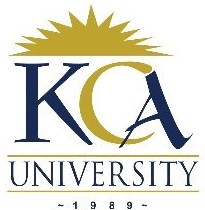 UNIVERSITY EXAMINATIONS: 2014/2015
UNIVERSITY EXAMINATIONS: 2014/2015
ORDINARY EXAMINATION FOR THE BACHELOR OF SCIENCE
IN INFORMATION TECHNOLOGY
BIT 1106A BCT 1101 OPERATING SYSTEMS
DATE: APRIL, 2015 TIME: 2 HOURS
INSTRUCTIONS: Answer Question ONE and any other TWO
QUESTION ONE
a) Explain the following terms as used in operating systems:
i) Command language [2 Marks]
ii) System nuclear [2 Marks]
iii) Hardware interrupts [2 Marks]
iv) Thrashing [2 Marks]
b) With the aid of a diagram, explain the relationship between operating system,
computer hardware, utility programs and application programs [6 Marks]
c) Identify four functions of the operating system. [4 Marks]
d) Describe at least two operating system structures. [4 Marks]
e) (i) Briefly explain four main performance criteria used to select a scheduling
algorithm. [4 Marks]
(ii) Describe the four conditions for deadlock in Operating System. [4 Marks]
QUESTION TWO
The process control block is a data structure containing certain important information
about the process. Identify the information contained in the PCB. [6 Marks]
a) Briefly explain six factors that may lead to a process switch. [6 Marks]
c) Discuss at least four objectives of file management. [8 Marks]
QUESTION THREE
a) Security goals of any computer system are decided by its security policies. Briefly
explain three computer security goals that can be set in an operating system.
[6 Marks]
b) State four types of security threats to consider when designing and implementing any
operating system. [4 Marks]
b) Most Modern Operating Systems support memory management with paging. Briefly
explain the following.
i) Page replacement algorithms [4 Marks]
ii) Fetch policies, outlining the two classes [3 Marks]
iii) Placement algorithm for non-paged system. [3 Marks]
QUESTION FOUR
a) Distinguish between a file system and a file control block. [4 Marks]
b) List four operations that are associated with files [4 Marks]
c) Discuss in detail four file organization methods. [8 Marks]
d) Describe two techniques that can be used to manage disk free space. [4 Marks]
QUESTION FIVE
a) Distinguish between the following pairs of terms:
i) Starvation and Deadlock [2 Marks]
ii) Fault avoidance and Error detection [2 Marks]
iii) Device driver and Device controller [2 Marks]
iv) Paging and segmentation [2 Marks]
b) Explain five desirable features of a process scheduling algorithm [5 Marks]
c) Describe the operation of Round Robin and Multilevel Feedback Queues scheduling
algorithms. [5 Marks]
a) Outline any two factors to consider in operating system design [2 Marks]
